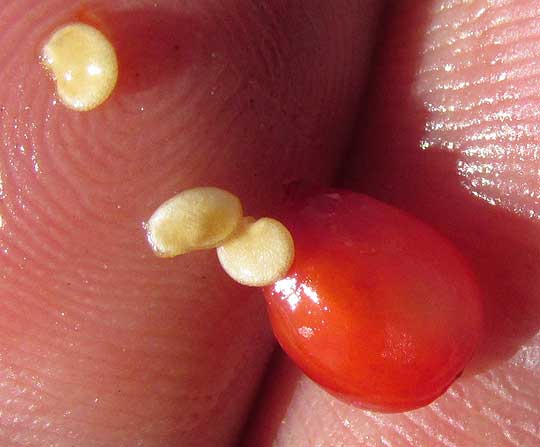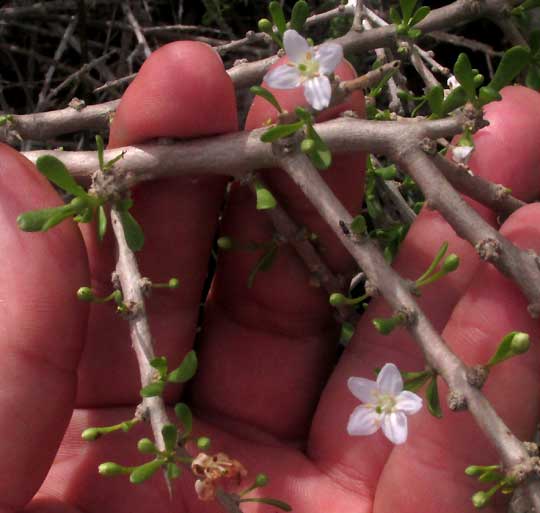Excerpts from Jim Conrad's
Naturalist Newsletter

from the November 2, 2014 Newsletter issued from Río Lagartos, on the Yucatan Peninsula's northern coast (~N21.60°, ~W88.16°), Yucatán state, MÉXICO
WOLFBERRY
Last week we looked at a knee-high, woody-stemmed bush with succulent leaves like those of the North's sedum plants, growing in salty mud at the side of mangroves. This week we have another plant looking very similar to that one -- despite not being related to it. It grew on salt-encrusted levees separating big salt ponds at the salt-exporting town of Las Coloradas on the coast about 15kms east of Río Lagartos. You might enjoy seeing how similar the two unrelated plants can look. Last week's Saltwort with sedum-like leaves is at www.backyardnature.net/yucatan/saltwort.htm.
This week's bush with similarly slender, whitish, woody stems and sedum-like leaves is shown above.
The main reason these two unrelated shrubs are so similar is that they employ similar adaptations to deal with extremely salty soil -- they're "halophytes." In both cases, succulent leaves (more cylindrical than flat in order to cut down on water evaporation from leaf surfaces) retain water during those long periods between rains when water can't be taken in through the roots because of the salty soil (unfavorable osmotic pressure). Whitish stems reflect intense sunlight bouncing off white, salt-encrusted soil.
The most noticeable difference between the plants is that last week's Saltwort bore yellow-green fruits while this week's plant produces bright red ones. A close-up of this week's plant's fruits is shown below:

When you squash that red fruit, little white, flat seeds pop out, looking very much like tiny tomato seeds, as shown below:

Seeing the fruit's resemblance to a tomato, already we can guess that this week's plant is a member of the Nightshade or Tomato/Potato Family, the Solanaceae. Once we know that, our plant is easy to figure out, because only a very small percentage of Solanaceae species produce succulent leaves.
This week's plant is variously known as Carolina Wolfberry, Carolina Desert-thorn, Creeping Wolfberry, Christmas berry and by other names. It's LYCIUM CAROLINIANUM, described as inhabiting ditches, ravines, depressions, swamps and marshes. It's distributed along most of Mexico's coastlines and here and there inland, and extends north into the US along the Gulf Coast from Texas to southeastern Georgia.
Wolfberry's red, tomato-like fruits are described as edible. I find them so small and seedy, and not particularly tasty (thought not unpleasant) that there's not much cause to nibble on them. Last week's succulent Saltwort leaves were worthy of sprinkling in salads to add a little salty crunch, but I'd hesitate to try that with Wolfberry's leaves, since members of the Solanaceae often contain powerful toxins, as with the case of Deadly Nightshade and the Tobacco plant.
Pictures on the Internet show that Wolfberry flowers are fair-sized, usually purplish, and typical of the Nightshade Family. Our plants bore only fruits at this time.
from the June 21, 2015 Newsletter issued from Río Lagartos, on the Yucatan Peninsula's northern coast (~N21.60°, ~W88.16°), Yucatán state, MÉXICO
WOLFBERRY FLOWERING
At the edges of salt marshes sometimes a slightly succulent but otherwise woody, profusely branched bush about eight feet high (2.5m) forms very tangled masses that only a mouse could comfortably work through. During the dry season the bushes mostly lose their leaves but now not only are they issuing new leaves but also flowers. You can see the whole thing below:

Up closer you see that the leaves are tiny, and the flowers white with four, sometimes five, corolla lobes, as seen below:

In that pictures, notice how short, leaf- and flower-bearing branches along the main stem are somewhat sharply pointed. The bush bears no "real" spines, but when you stick an arm into the tangle these "spinescent branches" are spiny enough.
In the flowers, stamens number the same as the corolla lobes and bear brownish anthers that stick up from the flower's throat, surrounding a stiff style tipped with a cauliflower-like, green stigma, as shown below:

If you peep into a flower's throat, you see that the throat is hairy enough to stop most insects from entering the corolla and maybe nibbling on the precious ovary, as seen below:

This is Wolfberry, LYCIUM CAROLINIANUM. I'd been expecting Wolfberry to produce blue to lavender flowers, because most Wolfberry flowers shown on the Internet are of those hues. However, descriptions admit that white-flowered ones exist, and now we know that we have those here.